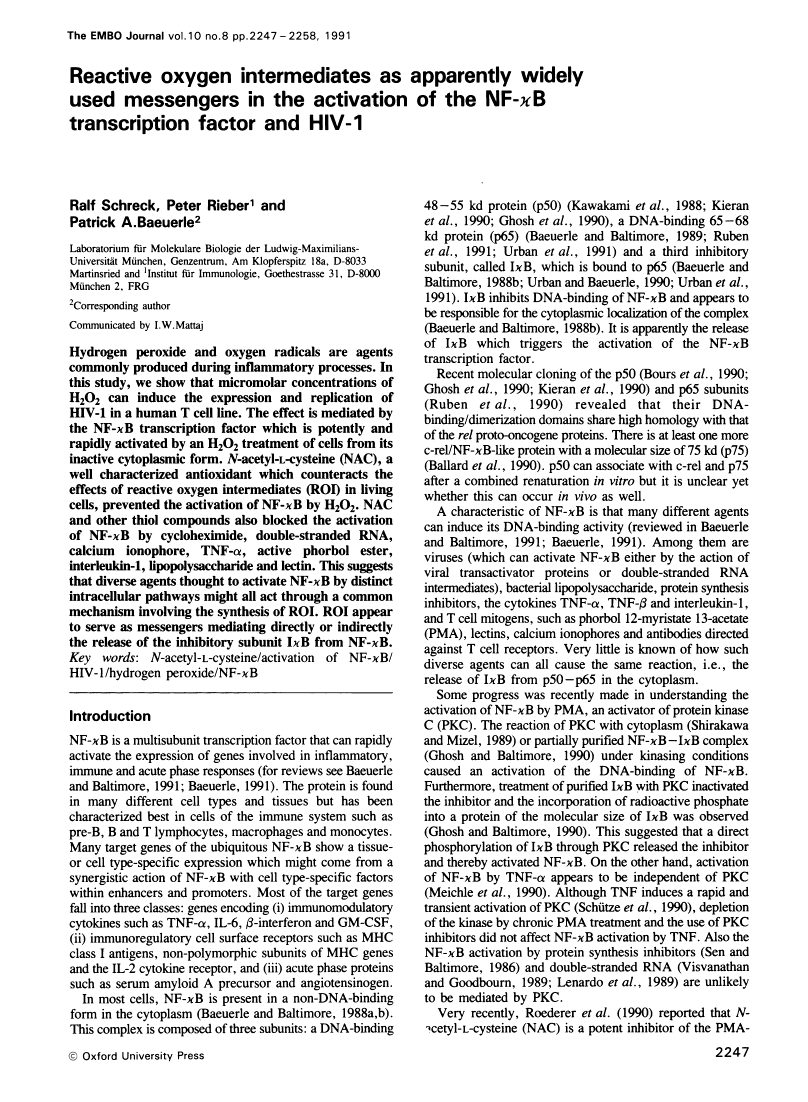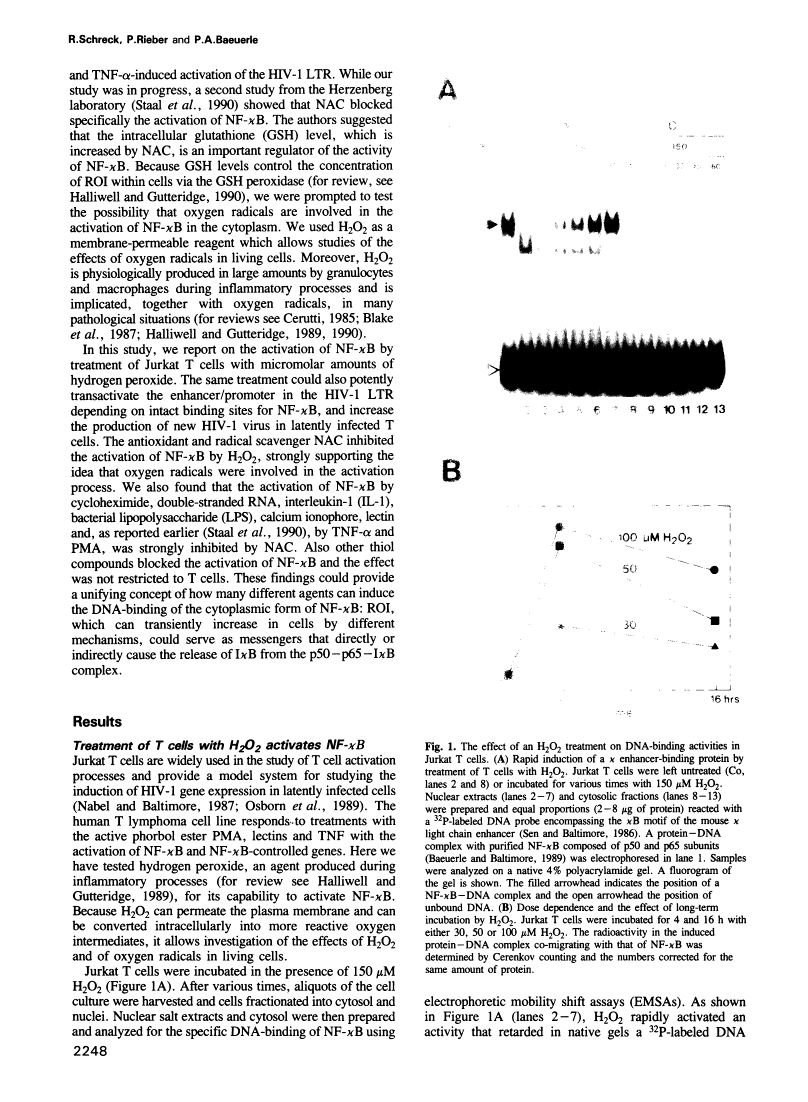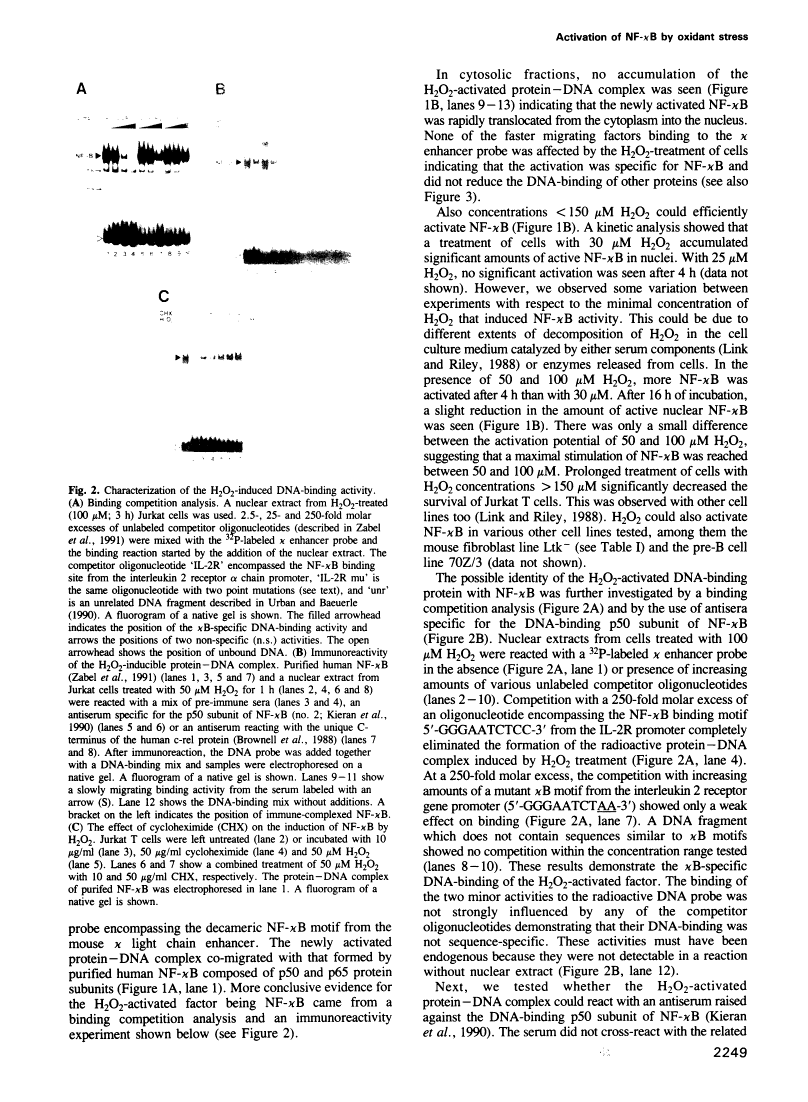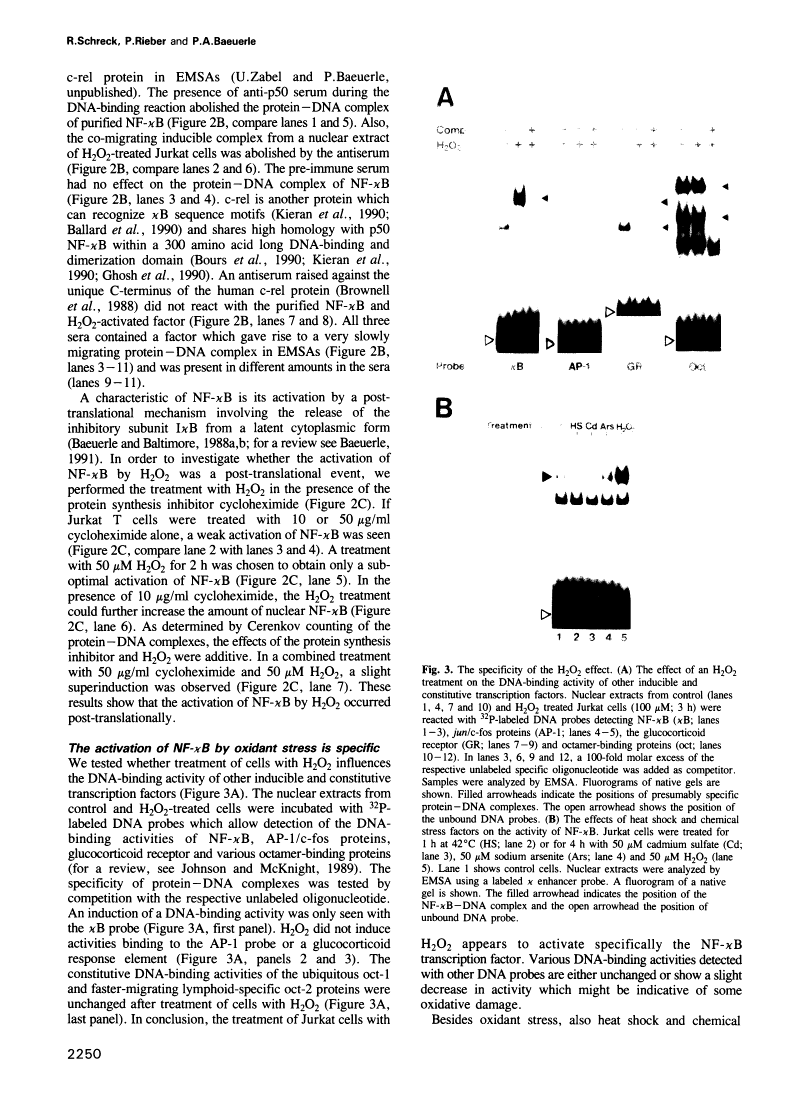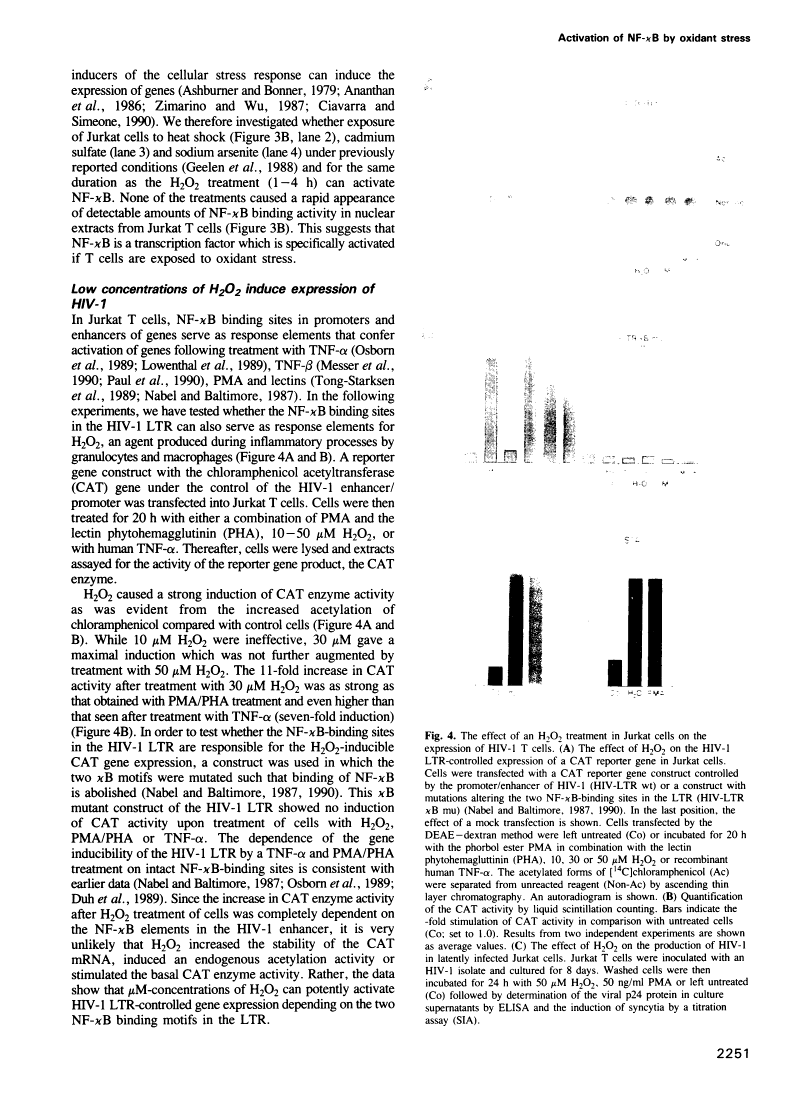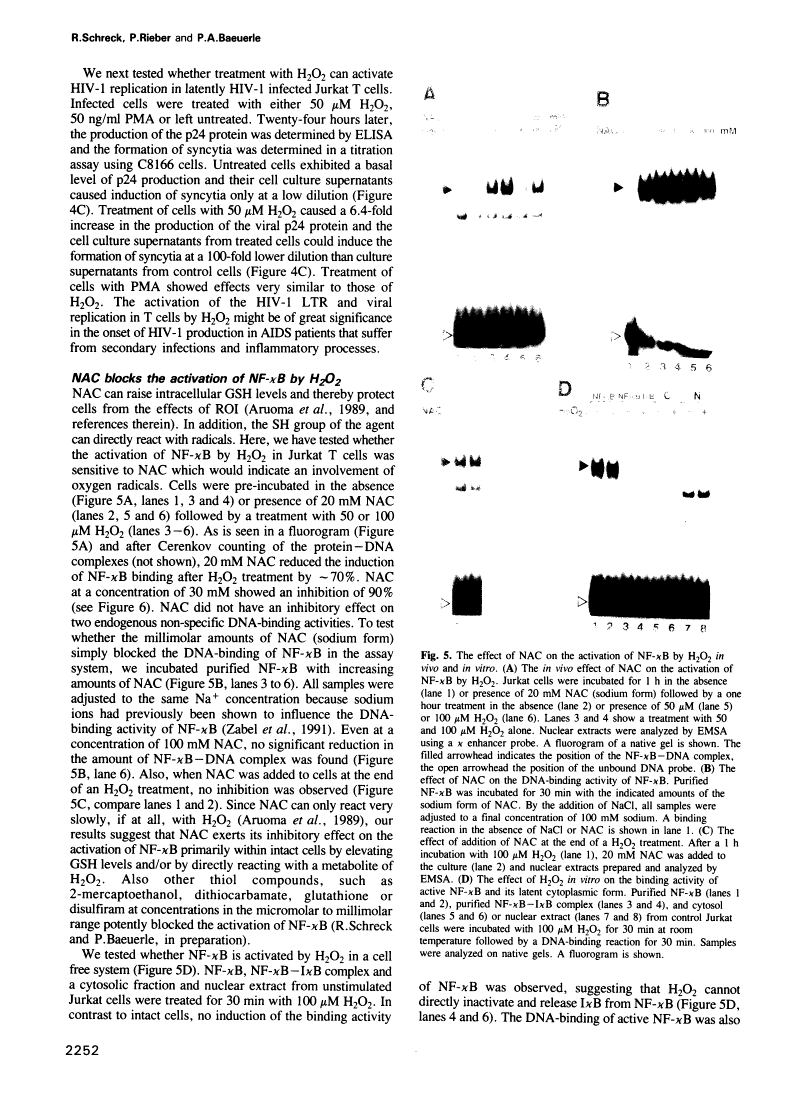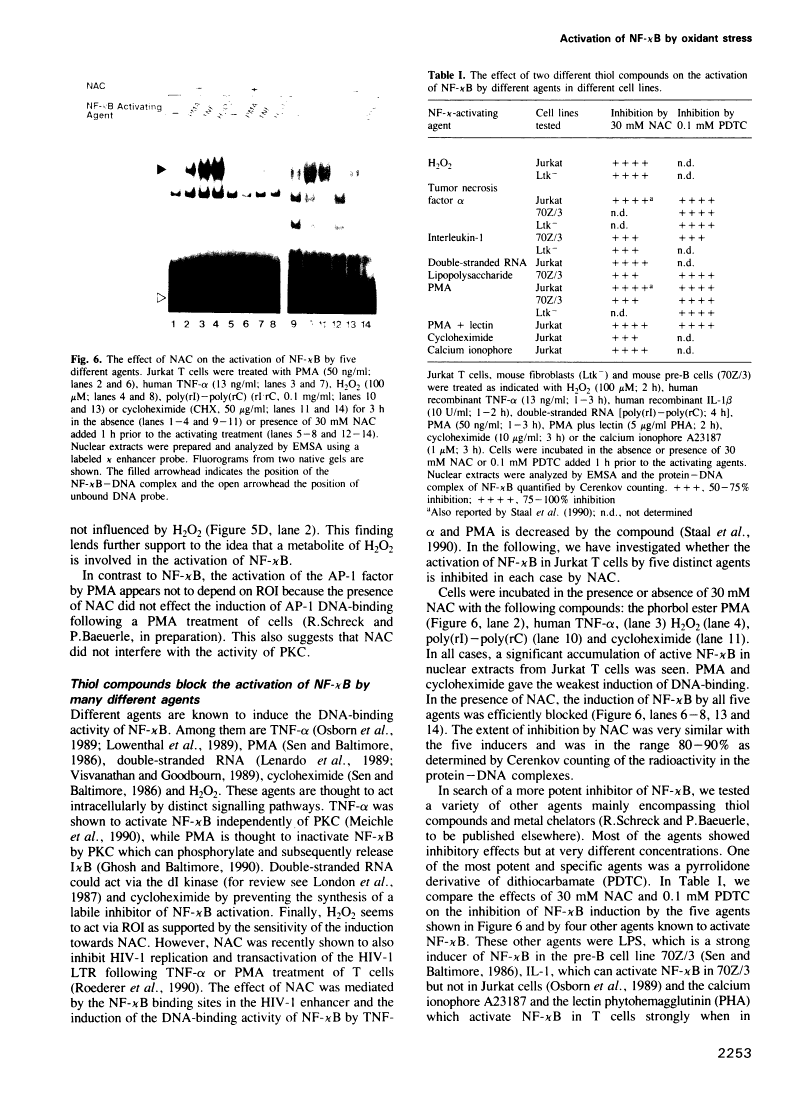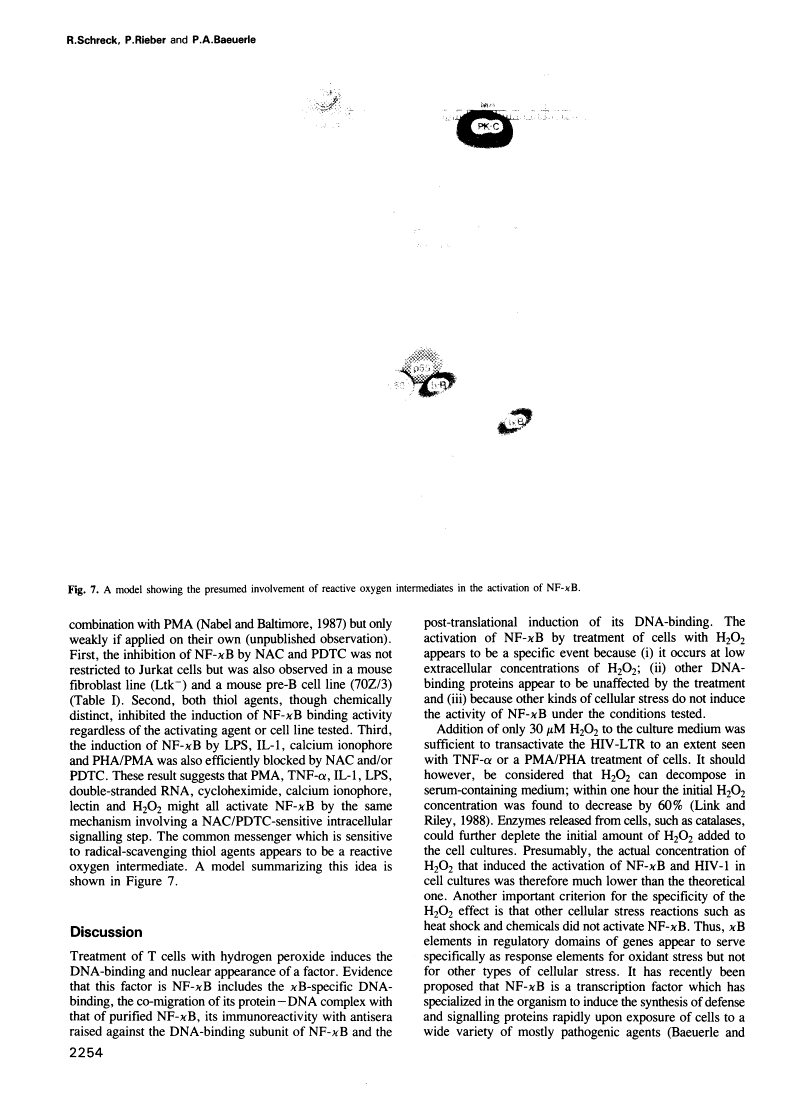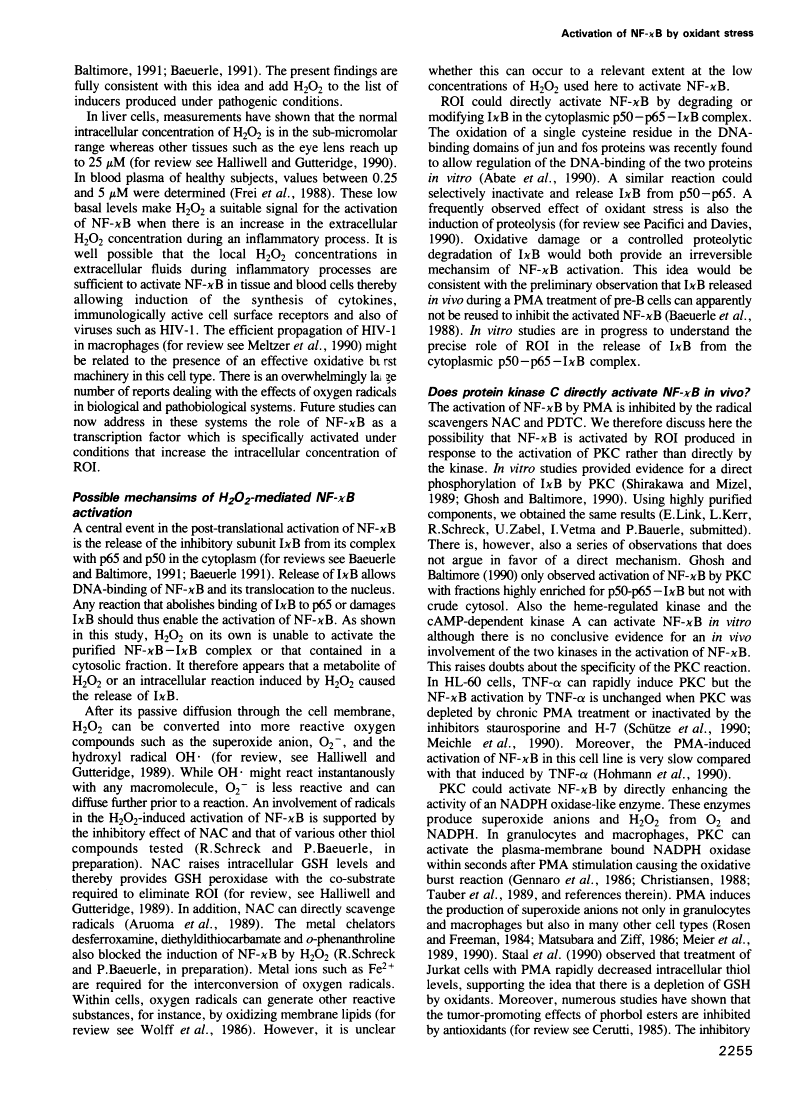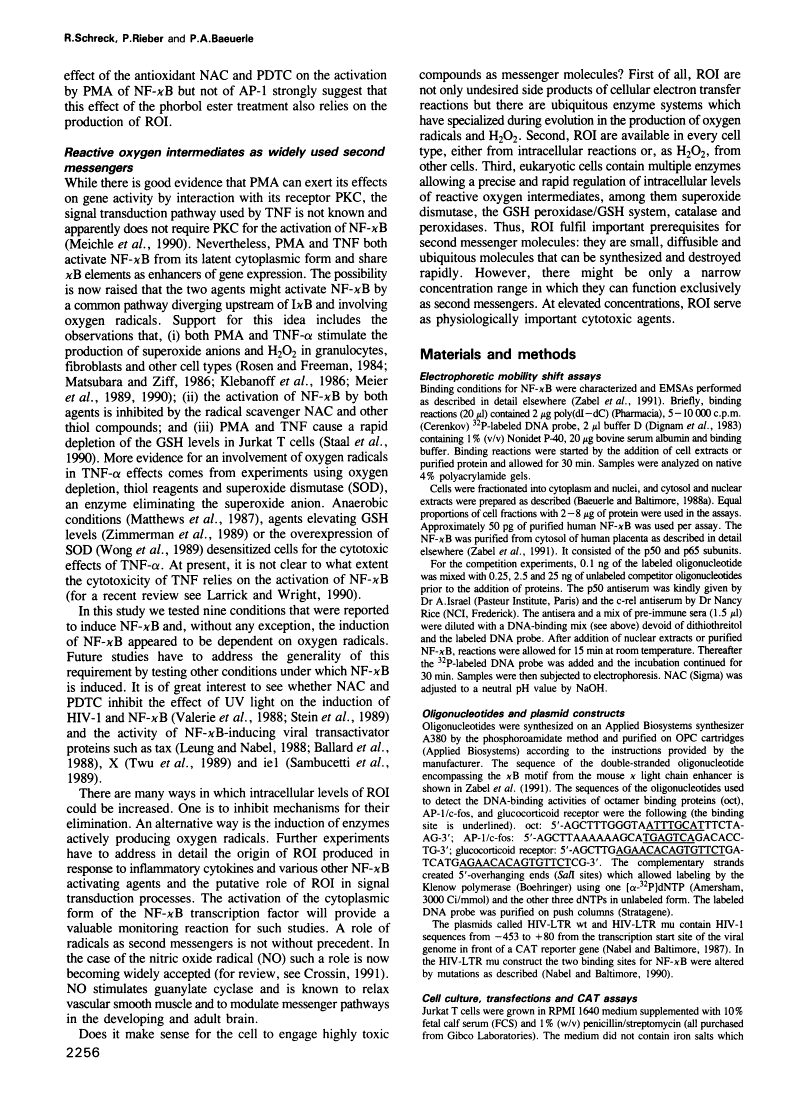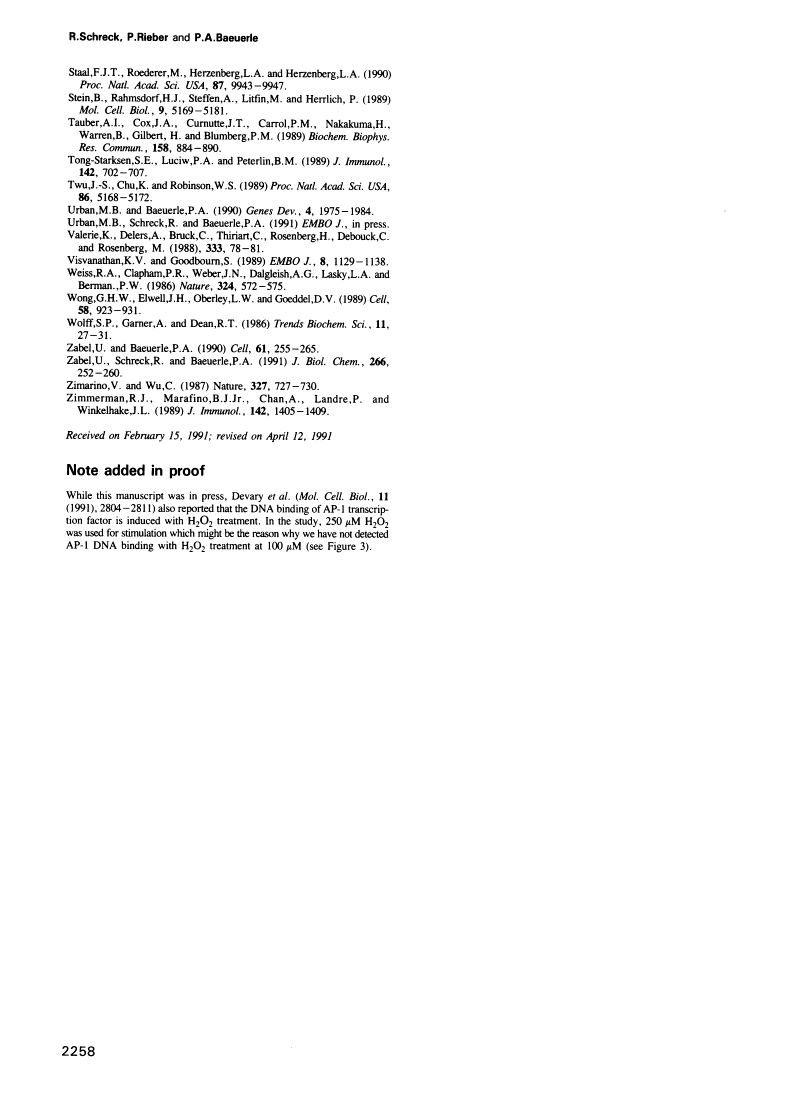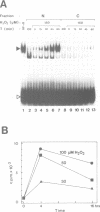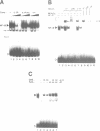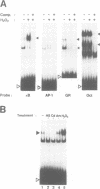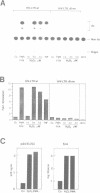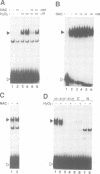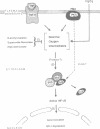Abstract
Free full text

Reactive oxygen intermediates as apparently widely used messengers in the activation of the NF-kappa B transcription factor and HIV-1.
Abstract
Hydrogen peroxide and oxygen radicals are agents commonly produced during inflammatory processes. In this study, we show that micromolar concentrations of H2O2 can induce the expression and replication of HIV-1 in a human T cell line. The effect is mediated by the NF-kappa B transcription factor which is potently and rapidly activated by an H2O2 treatment of cells from its inactive cytoplasmic form. N-acetyl-L-cysteine (NAC), a well characterized antioxidant which counteracts the effects of reactive oxygen intermediates (ROI) in living cells, prevented the activation of NF-kappa B by H2O2. NAC and other thiol compounds also blocked the activation of NF-kappa B by cycloheximide, double-stranded RNA, calcium ionophore, TNF-alpha, active phorbol ester, interleukin-1, lipopolysaccharide and lectin. This suggests that diverse agents thought to activate NF-kappa B by distinct intracellular pathways might all act through a common mechanism involving the synthesis of ROI. ROI appear to serve as messengers mediating directly or indirectly the release of the inhibitory subunit I kappa B from NF-kappa B.
Full text
Full text is available as a scanned copy of the original print version. Get a printable copy (PDF file) of the complete article (2.7M), or click on a page image below to browse page by page. Links to PubMed are also available for Selected References.
Images in this article
Click on the image to see a larger version.
Selected References
These references are in PubMed. This may not be the complete list of references from this article.
- Abate C, Patel L, Rauscher FJ, 3rd, Curran T. Redox regulation of fos and jun DNA-binding activity in vitro. Science. 1990 Sep 7;249(4973):1157–1161. [Abstract] [Google Scholar]
- Ananthan J, Goldberg AL, Voellmy R. Abnormal proteins serve as eukaryotic stress signals and trigger the activation of heat shock genes. Science. 1986 Apr 25;232(4749):522–524. [Abstract] [Google Scholar]
- Aruoma OI, Halliwell B, Hoey BM, Butler J. The antioxidant action of N-acetylcysteine: its reaction with hydrogen peroxide, hydroxyl radical, superoxide, and hypochlorous acid. Free Radic Biol Med. 1989;6(6):593–597. [Abstract] [Google Scholar]
- Ashburner M, Bonner JJ. The induction of gene activity in drosophilia by heat shock. Cell. 1979 Jun;17(2):241–254. [Abstract] [Google Scholar]
- Baeuerle PA, Baltimore D. Activation of DNA-binding activity in an apparently cytoplasmic precursor of the NF-kappa B transcription factor. Cell. 1988 Apr 22;53(2):211–217. [Abstract] [Google Scholar]
- Baeuerle PA, Baltimore D. I kappa B: a specific inhibitor of the NF-kappa B transcription factor. Science. 1988 Oct 28;242(4878):540–546. [Abstract] [Google Scholar]
- Baeuerle PA, Baltimore D. A 65-kappaD subunit of active NF-kappaB is required for inhibition of NF-kappaB by I kappaB. Genes Dev. 1989 Nov;3(11):1689–1698. [Abstract] [Google Scholar]
- Baeuerle PA, Lenardo M, Pierce JW, Baltimore D. Phorbol-ester-induced activation of the NF-kappa B transcription factor involves dissociation of an apparently cytoplasmic NF-kappa B/inhibitor complex. Cold Spring Harb Symp Quant Biol. 1988;53(Pt 2):789–798. [Abstract] [Google Scholar]
- Ballard DW, Böhnlein E, Lowenthal JW, Wano Y, Franza BR, Greene WC. HTLV-I tax induces cellular proteins that activate the kappa B element in the IL-2 receptor alpha gene. Science. 1988 Sep 23;241(4873):1652–1655. [Abstract] [Google Scholar]
- Ballard DW, Walker WH, Doerre S, Sista P, Molitor JA, Dixon EP, Peffer NJ, Hannink M, Greene WC. The v-rel oncogene encodes a kappa B enhancer binding protein that inhibits NF-kappa B function. Cell. 1990 Nov 16;63(4):803–814. [Abstract] [Google Scholar]
- Blake DR, Allen RE, Lunec J. Free radicals in biological systems--a review orientated to inflammatory processes. Br Med Bull. 1987 Apr;43(2):371–385. [Abstract] [Google Scholar]
- Bours V, Villalobos J, Burd PR, Kelly K, Siebenlist U. Cloning of a mitogen-inducible gene encoding a kappa B DNA-binding protein with homology to the rel oncogene and to cell-cycle motifs. Nature. 1990 Nov 1;348(6296):76–80. [Abstract] [Google Scholar]
- Bradford MM. A rapid and sensitive method for the quantitation of microgram quantities of protein utilizing the principle of protein-dye binding. Anal Biochem. 1976 May 7;72:248–254. [Abstract] [Google Scholar]
- Cerutti PA. Prooxidant states and tumor promotion. Science. 1985 Jan 25;227(4685):375–381. [Abstract] [Google Scholar]
- Christiansen NO. A time-course study on superoxide generation and protein kinase C activation in human neutrophils. FEBS Lett. 1988 Nov 7;239(2):195–198. [Abstract] [Google Scholar]
- Ciavarra RP, Simeone A. T lymphocyte stress response. II. Protection of translation and DNA replication against some forms of stress by prior hyperthermic stress. Cell Immunol. 1990 Nov;131(1):11–26. [Abstract] [Google Scholar]
- Crossin KL. Nitric oxide (NO): a versatile second messenger in brain. Trends Biochem Sci. 1991 Mar;16(3):81–82. [Abstract] [Google Scholar]
- Dignam JD, Lebovitz RM, Roeder RG. Accurate transcription initiation by RNA polymerase II in a soluble extract from isolated mammalian nuclei. Nucleic Acids Res. 1983 Mar 11;11(5):1475–1489. [Europe PMC free article] [Abstract] [Google Scholar]
- Duh EJ, Maury WJ, Folks TM, Fauci AS, Rabson AB. Tumor necrosis factor alpha activates human immunodeficiency virus type 1 through induction of nuclear factor binding to the NF-kappa B sites in the long terminal repeat. Proc Natl Acad Sci U S A. 1989 Aug;86(15):5974–5978. [Europe PMC free article] [Abstract] [Google Scholar]
- Frei B, Yamamoto Y, Niclas D, Ames BN. Evaluation of an isoluminol chemiluminescence assay for the detection of hydroperoxides in human blood plasma. Anal Biochem. 1988 Nov 15;175(1):120–130. [Abstract] [Google Scholar]
- Geelen JL, Minnaar RP, Boom R, van der Noordaa J, Goudsmit J. Heat-shock induction of the human immunodeficiency virus long terminal repeat. J Gen Virol. 1988 Nov;69(Pt 11):2913–2917. [Abstract] [Google Scholar]
- Gennaro R, Florio C, Romeo D. Co-activation of protein kinase C and NADPH oxidase in the plasma membrane of neutrophil cytoplasts. Biochem Biophys Res Commun. 1986 Jan 14;134(1):305–312. [Abstract] [Google Scholar]
- Ghosh S, Baltimore D. Activation in vitro of NF-kappa B by phosphorylation of its inhibitor I kappa B. Nature. 1990 Apr 12;344(6267):678–682. [Abstract] [Google Scholar]
- Ghosh S, Gifford AM, Riviere LR, Tempst P, Nolan GP, Baltimore D. Cloning of the p50 DNA binding subunit of NF-kappa B: homology to rel and dorsal. Cell. 1990 Sep 7;62(5):1019–1029. [Abstract] [Google Scholar]
- Gorman CM, Merlino GT, Willingham MC, Pastan I, Howard BH. The Rous sarcoma virus long terminal repeat is a strong promoter when introduced into a variety of eukaryotic cells by DNA-mediated transfection. Proc Natl Acad Sci U S A. 1982 Nov;79(22):6777–6781. [Europe PMC free article] [Abstract] [Google Scholar]
- Halliwell B, Gutteridge JM. Role of free radicals and catalytic metal ions in human disease: an overview. Methods Enzymol. 1990;186:1–85. [Abstract] [Google Scholar]
- Hohmann HP, Brockhaus M, Baeuerle PA, Remy R, Kolbeck R, van Loon AP. Expression of the types A and B tumor necrosis factor (TNF) receptors is independently regulated, and both receptors mediate activation of the transcription factor NF-kappa B. TNF alpha is not needed for induction of a biological effect via TNF receptors. J Biol Chem. 1990 Dec 25;265(36):22409–22417. [Abstract] [Google Scholar]
- Johnson PF, McKnight SL. Eukaryotic transcriptional regulatory proteins. Annu Rev Biochem. 1989;58:799–839. [Abstract] [Google Scholar]
- Kawakami K, Scheidereit C, Roeder RG. Identification and purification of a human immunoglobulin-enhancer-binding protein (NF-kappa B) that activates transcription from a human immunodeficiency virus type 1 promoter in vitro. Proc Natl Acad Sci U S A. 1988 Jul;85(13):4700–4704. [Europe PMC free article] [Abstract] [Google Scholar]
- Kieran M, Blank V, Logeat F, Vandekerckhove J, Lottspeich F, Le Bail O, Urban MB, Kourilsky P, Baeuerle PA, Israël A. The DNA binding subunit of NF-kappa B is identical to factor KBF1 and homologous to the rel oncogene product. Cell. 1990 Sep 7;62(5):1007–1018. [Abstract] [Google Scholar]
- Klebanoff SJ, Vadas MA, Harlan JM, Sparks LH, Gamble JR, Agosti JM, Waltersdorph AM. Stimulation of neutrophils by tumor necrosis factor. J Immunol. 1986 Jun 1;136(11):4220–4225. [Abstract] [Google Scholar]
- Larrick JW, Wright SC. Cytotoxic mechanism of tumor necrosis factor-alpha. FASEB J. 1990 Nov;4(14):3215–3223. [Abstract] [Google Scholar]
- Lenardo MJ, Fan CM, Maniatis T, Baltimore D. The involvement of NF-kappa B in beta-interferon gene regulation reveals its role as widely inducible mediator of signal transduction. Cell. 1989 Apr 21;57(2):287–294. [Abstract] [Google Scholar]
- Leung K, Nabel GJ. HTLV-1 transactivator induces interleukin-2 receptor expression through an NF-kappa B-like factor. Nature. 1988 Jun 23;333(6175):776–778. [Abstract] [Google Scholar]
- Link EM, Riley PA. Role of hydrogen peroxide in the cytotoxicity of the xanthine/xanthine oxidase system. Biochem J. 1988 Jan 15;249(2):391–399. [Europe PMC free article] [Abstract] [Google Scholar]
- Lowenthal JW, Ballard DW, Böhnlein E, Greene WC. Tumor necrosis factor alpha induces proteins that bind specifically to kappa B-like enhancer elements and regulate interleukin 2 receptor alpha-chain gene expression in primary human T lymphocytes. Proc Natl Acad Sci U S A. 1989 Apr;86(7):2331–2335. [Europe PMC free article] [Abstract] [Google Scholar]
- Matthews N, Neale ML, Jackson SK, Stark JM. Tumour cell killing by tumour necrosis factor: inhibition by anaerobic conditions, free-radical scavengers and inhibitors of arachidonate metabolism. Immunology. 1987 Sep;62(1):153–155. [Abstract] [Google Scholar]
- Matsubara T, Ziff M. Superoxide anion release by human endothelial cells: synergism between a phorbol ester and a calcium ionophore. J Cell Physiol. 1986 May;127(2):207–210. [Abstract] [Google Scholar]
- Meichle A, Schütze S, Hensel G, Brunsing D, Krönke M. Protein kinase C-independent activation of nuclear factor kappa B by tumor necrosis factor. J Biol Chem. 1990 May 15;265(14):8339–8343. [Abstract] [Google Scholar]
- Meier B, Radeke HH, Selle S, Younes M, Sies H, Resch K, Habermehl GG. Human fibroblasts release reactive oxygen species in response to interleukin-1 or tumour necrosis factor-alpha. Biochem J. 1989 Oct 15;263(2):539–545. [Europe PMC free article] [Abstract] [Google Scholar]
- Meier B, Radeke HH, Selle S, Habermehl GG, Resch K, Sies H. Human fibroblasts release low amounts of reactive oxygen species in response to the potent phagocyte stimulants, serum-treated zymosan, N-formyl-methionyl-leucyl-phenylalanine, leukotriene B4 or 12-O-tetradecanoylphorbol 13-acetate. Biol Chem Hoppe Seyler. 1990 Oct;371(10):1021–1025. [Abstract] [Google Scholar]
- Meltzer MS, Skillman DR, Hoover DL, Hanson BD, Turpin JA, Kalter DC, Gendelman HE. Macrophages and the human immunodeficiency virus. Immunol Today. 1990 Jun;11(6):217–223. [Abstract] [Google Scholar]
- Messer G, Weiss EH, Baeuerle PA. Tumor necrosis factor beta (TNF-beta) induces binding of the NF-kappa B transcription factor to a high-affinity kappa B element in the TNF-beta promoter. Cytokine. 1990 Nov;2(6):389–397. [Abstract] [Google Scholar]
- Nabel G, Baltimore D. An inducible transcription factor activates expression of human immunodeficiency virus in T cells. Nature. 1987 Apr 16;326(6114):711–713. [Abstract] [Google Scholar]
- Osborn L, Kunkel S, Nabel GJ. Tumor necrosis factor alpha and interleukin 1 stimulate the human immunodeficiency virus enhancer by activation of the nuclear factor kappa B. Proc Natl Acad Sci U S A. 1989 Apr;86(7):2336–2340. [Europe PMC free article] [Abstract] [Google Scholar]
- Pacifici RE, Davies KJ. Protein degradation as an index of oxidative stress. Methods Enzymol. 1990;186:485–502. [Abstract] [Google Scholar]
- Paul NL, Lenardo MJ, Novak KD, Sarr T, Tang WL, Ruddle NH. Lymphotoxin activation by human T-cell leukemia virus type I-infected cell lines: role for NF-kappa B. J Virol. 1990 Nov;64(11):5412–5419. [Europe PMC free article] [Abstract] [Google Scholar]
- Pomerantz RJ, Feinberg MB, Trono D, Baltimore D. Lipopolysaccharide is a potent monocyte/macrophage-specific stimulator of human immunodeficiency virus type 1 expression. J Exp Med. 1990 Jul 1;172(1):253–261. [Europe PMC free article] [Abstract] [Google Scholar]
- Roederer M, Staal FJ, Raju PA, Ela SW, Herzenberg LA, Herzenberg LA. Cytokine-stimulated human immunodeficiency virus replication is inhibited by N-acetyl-L-cysteine. Proc Natl Acad Sci U S A. 1990 Jun;87(12):4884–4888. [Europe PMC free article] [Abstract] [Google Scholar]
- Rosen GM, Freeman BA. Detection of superoxide generated by endothelial cells. Proc Natl Acad Sci U S A. 1984 Dec;81(23):7269–7273. [Europe PMC free article] [Abstract] [Google Scholar]
- Ruben SM, Dillon PJ, Schreck R, Henkel T, Chen CH, Maher M, Baeuerle PA, Rosen CA. Isolation of a rel-related human cDNA that potentially encodes the 65-kD subunit of NF-kappa B. Science. 1991 Mar 22;251(5000):1490–1493. [Abstract] [Google Scholar]
- Sambucetti LC, Cherrington JM, Wilkinson GW, Mocarski ES. NF-kappa B activation of the cytomegalovirus enhancer is mediated by a viral transactivator and by T cell stimulation. EMBO J. 1989 Dec 20;8(13):4251–4258. [Europe PMC free article] [Abstract] [Google Scholar]
- Schütze S, Nottrott S, Pfizenmaier K, Krönke M. Tumor necrosis factor signal transduction. Cell-type-specific activation and translocation of protein kinase C. J Immunol. 1990 Apr 1;144(7):2604–2608. [Abstract] [Google Scholar]
- Sen R, Baltimore D. Inducibility of kappa immunoglobulin enhancer-binding protein Nf-kappa B by a posttranslational mechanism. Cell. 1986 Dec 26;47(6):921–928. [Abstract] [Google Scholar]
- Shirakawa F, Mizel SB. In vitro activation and nuclear translocation of NF-kappa B catalyzed by cyclic AMP-dependent protein kinase and protein kinase C. Mol Cell Biol. 1989 Jun;9(6):2424–2430. [Europe PMC free article] [Abstract] [Google Scholar]
- Staal FJ, Roederer M, Herzenberg LA, Herzenberg LA. Intracellular thiols regulate activation of nuclear factor kappa B and transcription of human immunodeficiency virus. Proc Natl Acad Sci U S A. 1990 Dec;87(24):9943–9947. [Europe PMC free article] [Abstract] [Google Scholar]
- Stein B, Rahmsdorf HJ, Steffen A, Litfin M, Herrlich P. UV-induced DNA damage is an intermediate step in UV-induced expression of human immunodeficiency virus type 1, collagenase, c-fos, and metallothionein. Mol Cell Biol. 1989 Nov;9(11):5169–5181. [Europe PMC free article] [Abstract] [Google Scholar]
- Tauber AI, Cox JA, Curnutte JT, Carrol PM, Nakakuma H, Warren B, Gilbert H, Blumberg PM. Activation of human neutrophil NADPH-oxidase in vitro by the catalytic fragment of protein kinase-C. Biochem Biophys Res Commun. 1989 Feb 15;158(3):884–890. [Abstract] [Google Scholar]
- Tong-Starkesen SE, Luciw PA, Peterlin BM. Signaling through T lymphocyte surface proteins, TCR/CD3 and CD28, activates the HIV-1 long terminal repeat. J Immunol. 1989 Jan 15;142(2):702–707. [Abstract] [Google Scholar]
- Twu JS, Chu K, Robinson WS. Hepatitis B virus X gene activates kappa B-like enhancer sequences in the long terminal repeat of human immunodeficiency virus 1. Proc Natl Acad Sci U S A. 1989 Jul;86(13):5168–5172. [Europe PMC free article] [Abstract] [Google Scholar]
- Urban MB, Baeuerle PA. The 65-kD subunit of NF-kappa B is a receptor for I kappa B and a modulator of DNA-binding specificity. Genes Dev. 1990 Nov;4(11):1975–1984. [Abstract] [Google Scholar]
- Valerie K, Delers A, Bruck C, Thiriart C, Rosenberg H, Debouck C, Rosenberg M. Activation of human immunodeficiency virus type 1 by DNA damage in human cells. Nature. 1988 May 5;333(6168):78–81. [Abstract] [Google Scholar]
- Visvanathan KV, Goodbourn S. Double-stranded RNA activates binding of NF-kappa B to an inducible element in the human beta-interferon promoter. EMBO J. 1989 Apr;8(4):1129–1138. [Europe PMC free article] [Abstract] [Google Scholar]
- Weiss RA, Clapham PR, Weber JN, Dalgleish AG, Lasky LA, Berman PW. Variable and conserved neutralization antigens of human immunodeficiency virus. Nature. 1986 Dec 11;324(6097):572–575. [Abstract] [Google Scholar]
- Wong GH, Elwell JH, Oberley LW, Goeddel DV. Manganous superoxide dismutase is essential for cellular resistance to cytotoxicity of tumor necrosis factor. Cell. 1989 Sep 8;58(5):923–931. [Abstract] [Google Scholar]
- Zabel U, Baeuerle PA. Purified human I kappa B can rapidly dissociate the complex of the NF-kappa B transcription factor with its cognate DNA. Cell. 1990 Apr 20;61(2):255–265. [Abstract] [Google Scholar]
- Zabel U, Schreck R, Baeuerle PA. DNA binding of purified transcription factor NF-kappa B. Affinity, specificity, Zn2+ dependence, and differential half-site recognition. J Biol Chem. 1991 Jan 5;266(1):252–260. [Abstract] [Google Scholar]
- Zimarino V, Wu C. Induction of sequence-specific binding of Drosophila heat shock activator protein without protein synthesis. Nature. 327(6124):727–730. [Abstract] [Google Scholar]
- Zimmerman RJ, Marafino BJ, Jr, Chan A, Landre P, Winkelhake JL. The role of oxidant injury in tumor cell sensitivity to recombinant human tumor necrosis factor in vivo. Implications for mechanisms of action. J Immunol. 1989 Feb 15;142(4):1405–1409. [Abstract] [Google Scholar]
Associated Data
Articles from The EMBO Journal are provided here courtesy of Nature Publishing Group
Full text links
Read article at publisher's site: https://doi.org/10.1002/j.1460-2075.1991.tb07761.x
Read article for free, from open access legal sources, via Unpaywall:
https://onlinelibrary.wiley.com/doi/pdfdirect/10.1002/j.1460-2075.1991.tb07761.x
Citations & impact
Impact metrics
Citations of article over time
Alternative metrics
Smart citations by scite.ai
Explore citation contexts and check if this article has been
supported or disputed.
https://scite.ai/reports/10.1002/j.1460-2075.1991.tb07761.x
Article citations
The Nrf2-HO-1 system and inflammaging.
Front Immunol, 15:1457010, 24 Sep 2024
Cited by: 0 articles | PMID: 39380993 | PMCID: PMC11458407
Review Free full text in Europe PMC
A Mechanism for Apoptotic Effects of a Planar Catechin Analog on Cancer Cells.
Molecules, 29(18):4467, 20 Sep 2024
Cited by: 0 articles | PMID: 39339462 | PMCID: PMC11433776
Exploring the Thioredoxin System as a Therapeutic Target in Cancer: Mechanisms and Implications.
Antioxidants (Basel), 13(9):1078, 04 Sep 2024
Cited by: 0 articles | PMID: 39334737 | PMCID: PMC11428833
Review Free full text in Europe PMC
Oxidative State in Cutaneous Melanoma Progression: A Question of Balance.
Antioxidants (Basel), 13(9):1058, 30 Aug 2024
Cited by: 0 articles | PMID: 39334716 | PMCID: PMC11428248
Review Free full text in Europe PMC
Advances in the application and mechanism of bioactive peptides in the treatment of inflammation.
Front Immunol, 15:1413179, 23 Aug 2024
Cited by: 0 articles | PMID: 39247182 | PMCID: PMC11377253
Review Free full text in Europe PMC
Go to all (2,167) article citations
Similar Articles
To arrive at the top five similar articles we use a word-weighted algorithm to compare words from the Title and Abstract of each citation.
Transcription factor NF-kappa B is activated by photosensitization generating oxidative DNA damages.
J Biol Chem, 270(12):6925-6934, 01 Mar 1995
Cited by: 40 articles | PMID: 7896842
Rapid proteolysis of I kappa B-alpha is necessary for activation of transcription factor NF-kappa B.
Nature, 365(6442):182-185, 01 Sep 1993
Cited by: 709 articles | PMID: 8371761
The binding of immobilized IgG2a to Fc gamma 2a receptor activates NF-kappa B via reactive oxygen intermediates and tumor necrosis factor-alpha 1.
J Biol Chem, 269(48):30561-30568, 01 Dec 1994
Cited by: 22 articles | PMID: 7982975
[Free radicals as second messengers].
C R Seances Soc Biol Fil, 189(3):355-366, 01 Jan 1995
Cited by: 0 articles | PMID: 8521084
Review
